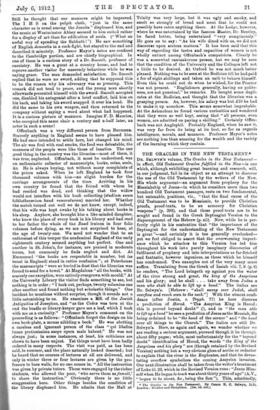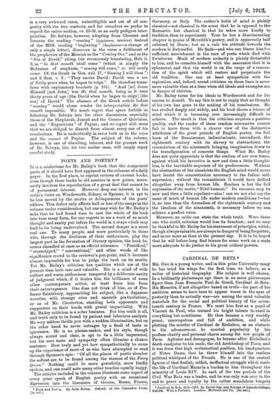THE ORACLES IN THE NEW TESTAIIENT.* Du. SELWYN'S volume, The
Oracles in the New Testament— in effect, Old Testament Oracles fulfilled in the New—is one which, although exhibiting great learning and research, will, in our judgment, fail in its object as an attempt to discover the use of the Old Testament by the writers of the New. His whole argument—an argument from prophecy for the Messiahship of Jesus—in which be considers more than two hundred Old Testament passages, rests on two fundamental, but untenable, positions, viz., " that the final cause of the Old Testament was to be Messianic, to provide Christian proofs, proof-texts, to be an armoury for Christian weapons" (p. 398), and that these proof-texts are to be sought and found in the Greek Septuagint Version to the disparagement of the Hebrew (p. xii). Now, while he is per- fectly right in his contention that "the importance of the Septuagint for the understanding of the New Testament is great "—and certainly it is too generally overlooked— yet we feel obliged to assert that the overweening import- ance which he attaches to this Version has led him throughout his work into purely imaginary discoveries of fulfilment of prophecy and into interpretations as far-fetched and fantastic, however ingenious, as those which he himself has condemned. Two examples out of the very many must suffice. Translating from the Greek of Isaiah viii. 7, 8 (p. 8) he renders, " The Lord bringeth up against you the water of the river strong and great, the king of the Assyrians and his glory; and he shall . . . take away from Judea a man who shall be able to lift up a head." The italics are Dr. Selwyn's. [Hebrew : "shall sweep over Judah, shall overflow and reach even to the neck."] With the utmost confi- dence (after Justin, c. Tryph. 77) he here discerns a prediction of Herod. "The Assyrian King is Herod : this is proved beyond doubt" (!), and in " the man able to lift up a head" he sees a prediction of Jesus as the Messiah, He being ordained to be "the head of the corner" and "the head over all things to the Church." The italics are still Dr. Selwyn's. Here, as again and again, we wonder whether we are reading a serious argument, pursued though it be through about fifty pages ; while, most unfortunately for the " beyond doubt" identification of Herod, the words " the King of the Assyrians and his glory" are (though retained by the Revised Version) nothing but a very obvious gloss of scribe or redactor to explain that the river is the Euphrates, and that its devas- tating overflow symbolizes the coming Assyrian invasion. Our next illustration shall be taken from the writer's treatment of Luke iii. 23, which in the Revised Version runs : "Jesus Him- self when He began to teach was about thirty years of age" (A.V., " began to be about, Ice., being the Son "). This, admittedly, * The Oracles in the New Tutasswit. By Canon B. C. Selwyn, D.D. London : Hodder and Stoughton. Lids. 61 net.]
is a very awkward verse, unintelligible and out of all con- gruity with the two contexts, and for ourselves we prefer to regard the entire section, vv. 23.36, as an early pedigree inter- polation. Dr. Selwyn, however, adopting from Clement and Irenmus the reading " coming" (OrSuepos, veniens) instead of the MSS. reading " beginning " (lEmelereer—a change of only a single letter), discovers in the verse a fulfilment of the prophecies of the Messiah as the " Coming One" and as the " Son of David," citing, but erroneously translating, Hab.
3, as " he that cometh shall come " (which is simply the Hebraism of emphasis, " corning will come," sc. will surely come. Cf. the Greek in Gen. xxii. 17, " blessing I will bless ") and 2 Sam. v. 3: "They anoint David: David was a son of thirty years when he began to reign." He therefore trans- lates with explanatory brackets (p. 151). "And [so] Jesus Himself [not John] was He that cometh, being as it were thirty years of age [like David when he began to reign] [the son] of David." The absence of the Greek article before " coming " would alone render the interpretation Be that cometh impossible. We much regret that space forbids us following Dr. Selwyn into his other discussions, especially those of the Shepherds, Joseph and the Census of Quirinius, and the " Expositions " of Papias ; and we regret still more that we are obliged to dissent from almost every one of his conclusions. He is undoubtedly in error both as to the mera and the eeperfal of Papias. The subject of the volume, however, is one of absorbing interest, and the present work of Dr. Selwyn, like his two earlier ones, will amply repay careful study.



















































 Previous page
Previous page